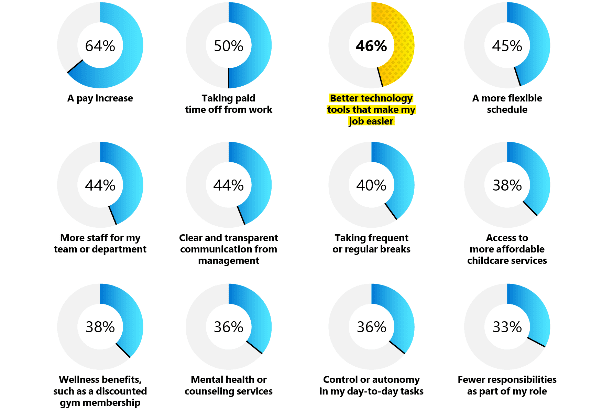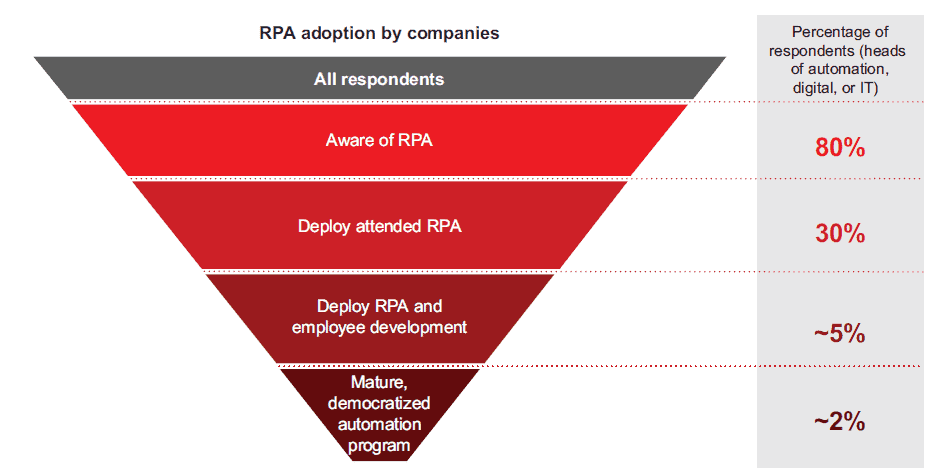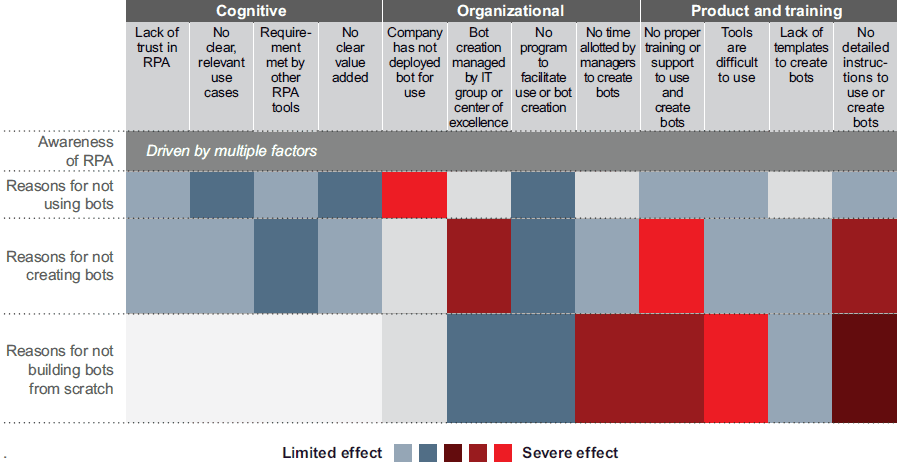2022 Automation Trends: the New Barriers to RPA
Before 2022, people had a fear-based mentality, approach, and lack of acceptance when it came to deploying automations. Now in 2022, fear is no longer the barrier to RPA. One of our directors shares the 2022 automation trends and barriers we’re now seeing in the automation space.
The progression in which companies have adopted automation has accelerated so much that the perspective of Robotic Process Automation (RPA) has changed drastically. For 2022 automation trends, it’s obvious the barriers to entry for RPA have greatly evolved in just the last 12 months alone. Microsoft’s latest Work Trend Index has revealed front-line workers no longer fear automation taking their jobs. In fact, they desire more training and education as they are hungry for the opportunity it could bring. Further, new reports indicate automation is more entrenched in company strategies, but access is still limited.
RPA was on the path of every typical, emerging, technology-adoption curve. We were just past the point of every news source posting their “Is RPA dead?” article. Based on anecdotal evidence, RPA wasn’t going to make the cut. When the technology starts to make everyone a bit uncomfortable, and it’s decision-making time – are you going to be an early majority to adopt? No? Okay then, let’s poke holes in the likelihood that RPA will be the next big thing.
This was the 2019/2020 mindset, and now things have changed. This is the only time you’ll hear me talk about the pandemic here because the point of this story is to illustrate how fast RPA has evolved into a common tool, simply because Covid-19 happened.
That was then. This is now.
There are plenty of reports, studies, and speculation released with 2020 and 2021 publishing dates, explaining how automation was propelled into existence because of the state of the workforce. In a normal summation of said studies, I would reference those reports, barely a year of age.
However, what was relevant business forecasting last summer has changed greatly. All because of the workforce’s perspective on supply chain interruptions, and the value of human employees creating value and feeling valued.
We assessed studies and reports released in ONLY the last 3 months. Anything with sources originating prior to December 2021 aren’t included. So this is the freshest, most real look at what the mindset is around embracing technology and 2022 automation trends.
We examined multiple sources we’ll mention shortly and provided links to everything, so you can see for yourself.
2022 Automation Trend: Fear of Automation?
Automation is not feared anymore. It’s believed in and entrusted when education is provided.
I remember because it was only a few years ago – a time when we spent nearly all our energy building sales copy, blog posts, and pitches around dispelling the myths of RPA, and why it’s NOT coming to take your jobs.
One leader at a company would often come to butt heads with another leader because of their conflicting fundamental beliefs. Sometimes you’d think you can move past the education and focus purely on the ROI calculators, showing how much time and money you’d save on one particular use case. Only to take one giant leap backward to set the tone for what a future state would look like, and it wasn’t an open office full of humanoid robots with only two very frightened humans in their corner cubicles.
Here are the facts: 63% of frontline workers are excited about the job opportunities technology creates. In Microsoft’s Work Trend Index, they listed those specific places in which workers could imagine improvements with:
Rapid digital transformation for information workers has already taken hold, and now Microsoft foretells a future where the frontline workers are at a similar inflection point with automation and AI.
One of the things I say to people is that you have to see machine learning and AI as an assistant, not a replacement, for expertise.

Image courtesy of Microsoft
However, access to training is getting in the way. The tech and training gap is a real concern in many sources, indicating staff in all areas of the business are ready, but the training for it may not be available.
Access to―and training for―technology that automates tasks, provides remote assistance, and helps workers communicate with each other varies widely among frontline workers. Our research shows that healthcare, hospitality, telecommunications, and automotive/transportation have all lagged in training employees prior to implementing the latest digital tools.
Not only prioritizing training but modernizing it, remains one of the best ways to keep workers on staff. 46% of them worry they could lose their job without it, and others leave for new experiences because they aren’t receiving the training!
Democratization is Key
In a report called “Overcoming the Automation Paradox” by UiPath and Bain & Company, they speak to the importance of democratizing access and a Center of Excellence (CoE).

Image courtesy of: Bain/UiPath Citizen Development Survey
The barriers to meaningful progress towards democratizing automation are due to four perceptions the study reveals:
When looking at all the possible barriers for RPA in 2022, this study indicates that the biggest burden of all is in training.

Image courtesy of: Bain/UiPath Citizen Development Survey
One final thought on this observation comes from Forrester’s Vice President & Research Director, Pascal Matzke. In a recent presentation called, “A Future Fit Tech Strategy Helps To Manage Continual Change”, he said that a “center of excellence is not a center of expertise.” He struggles with the concept of a CoE because companies use it to shield an experience rather than share. Successful adoption is about the technology being openly shared like a community.
How does this look in your organization?
The Rise of Transformational Automation
The second and final observation introduces a rising term in business transformation: Transformational Automation.
Transformational Automation is the new BHAG. Not a reader of Jim Collins? It’s your company’s Big Hairy Audacious Goal.
Forrester VP, Matzke, says that in order to react to continual change and create durable, consistent work, you can’t have a myopic view of automation. In other words, future-fit technology is not based on tactical approaches to automation because it undersells its transformative potential. Islands of automation, overreliance on a single automation technology, and tactical approaches create technical debt.
The flipside of the coin is strategic automation that boosts innovation, and this is done with automation fabric. Automation fabric is when convergent technologies enmesh and interconnect, abstracting application functionality from the layer beneath to surface them to users.
RPA is one such automation tool, among many, that are diverse as well as complimentary. Here are other automation fabric tools:
When Matzke explains that transformational automation is the new BHAG (or moonshot, his word, your choice), he describes it as being a way to converge fragmented automation initiatives, governing them holistically.
An example of transformational automation is how Amazon is wildly successful at being customer-obsessed. Amazon injects AI and predictive analytics into their processes, and there’s no way they could deliver on their promises without it.
2022 Automation Trends
In UiPath’s observations about 2022 Automation Agendas, the question they pose is whether you’re being ambitious enough or not. A CIO of a major public company shared a story with UiPath about how their board members are pushing for a new, healthier relationship with automation. “Now, they’re asking us to develop and implement a plan to turn automation into a core competency across the entire enterprise. They want us to use it as a strategic weapon to gain long-term competitive advantage.”
You might think this observation is more of an opportunity, rather than a barrier to RPA, and that’s a healthy mindset to have. However, it’s more common for organizations to fall into the trap of creating tactical automation islands that lack governance and a holistic automation fabric strategy. This is the trap most organizations are looking to not fall into. The best way to do that is to build a future-fit technology strategy that is based on solving for efficiency.
Whether or not you believe transformational automation is realistic in the short-term, intelligent automation is likely the stepping stone that is well within the grasp of 2022 goals. Infusing AI and machine learning into RPA will offer opportunities for newer forms of engagement and future use cases.
What about in your organization?
Looking for more on automation?
Explore more insights and expertise at smartbridge.com/automation
Keep Reading: Starting Your RPA Center of Excellence
There’s more to explore at Smartbridge.com!
Sign up to be notified when we publish articles, news, videos and more!
Other ways to
follow us:


